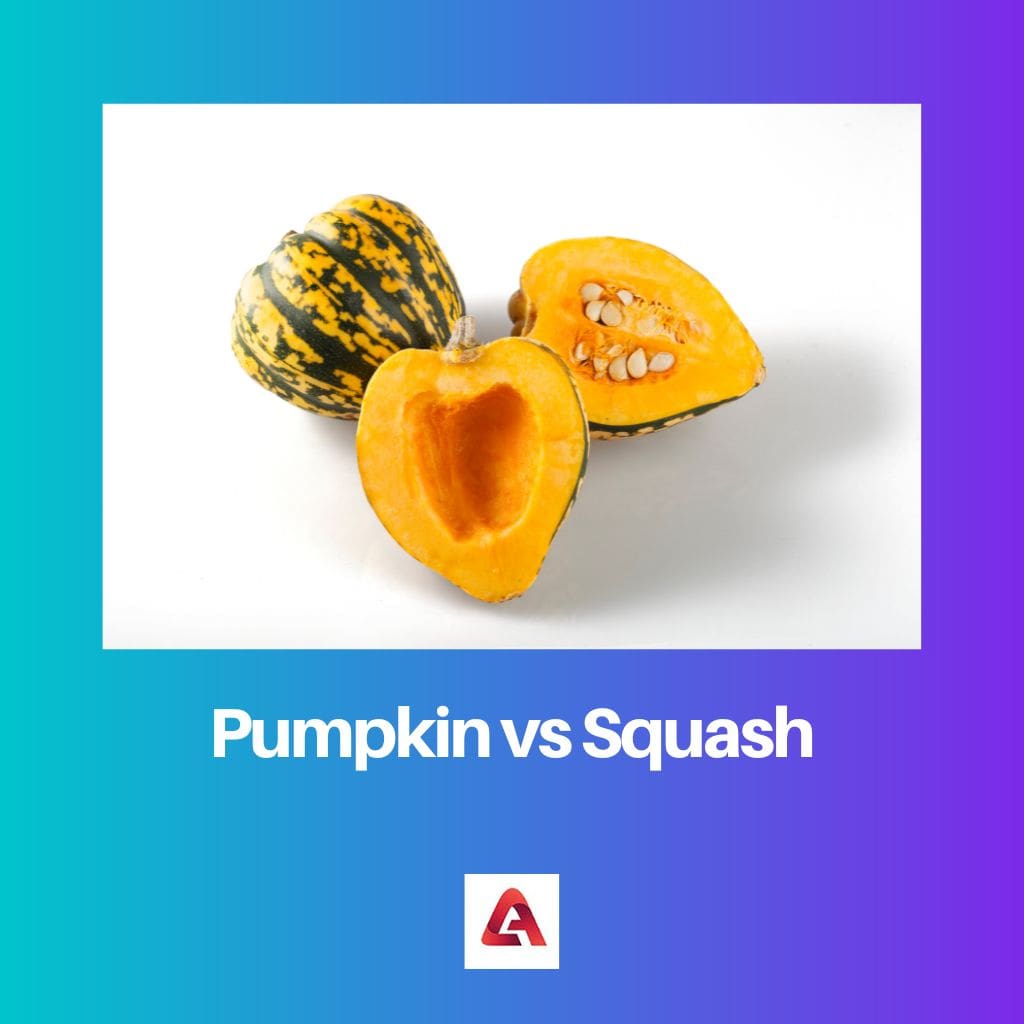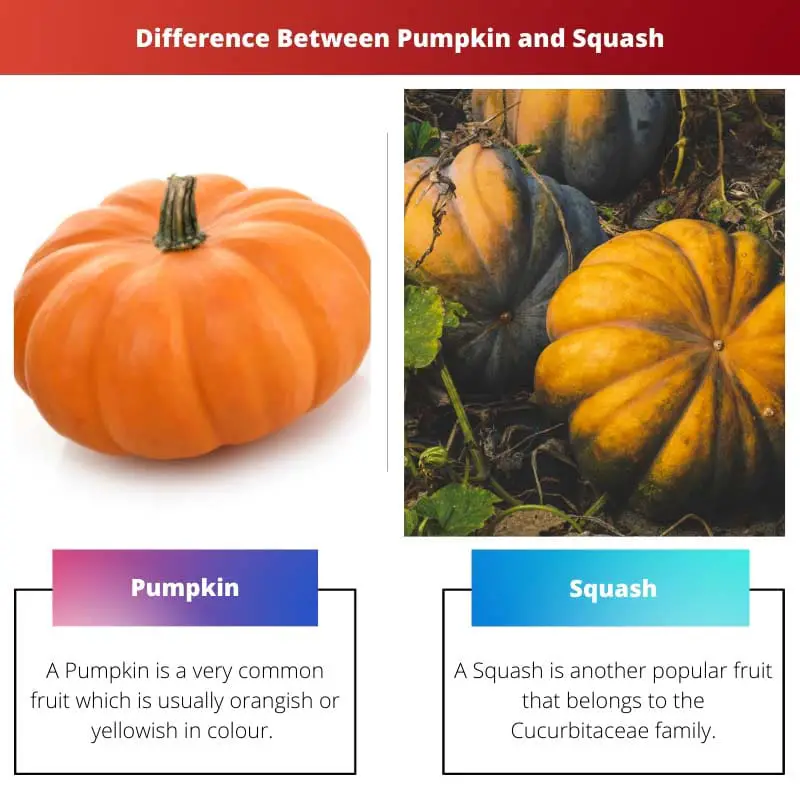The Cucurbitaceae family pretty much dominates the beautiful season of fall. Various food items in the Cucurbitaceae family include gourds, pumpkin, squash, etc.
The Latin name for all these food items collectively is the Cucurbitaceae family.
Key Takeaways
- Pumpkins are a type of squash, specifically a winter squash, characterized by their round shape, orange color, thick skin, and fibrous, slightly sweet flesh.
- Squash is a broader category encompassing various species of Cucurbita, including both summer and winter varieties, with diverse shapes, colors, and flavors.
- The distinction between pumpkins and squash is based on the classification of pumpkins as a specific type of winter squash, while squash refers to a wider range of related plants.
Pumpkin vs. Squash
The main difference between Pumpkin and Squash is that Pumpkin has a hard and jagged stem. The seeds of Pumpkin are rich in fatty acids. On the other hand, the stem of a Squash is light and hollow. The seeds of Squash are rich in fiber and protein.

Two of the most common members of this family are Pumpkin and Squash. Both these words are seen to confuse most of the people.
The confusion is because both are fruits that grow on a vine and belong to the same family. There is little difference between Pumpin and Squash. Most people are unaware of the differences that exist between them.
Comparison Table
| Parameter of Comparison | Pumpkin | Squash |
|---|---|---|
| Stem | The stem of a Pumpkin is firm and hard. | The stem of a Squash is loose and hollow. |
| Availability | Pumpkins are harvested in September and are available in stores till November. | Squashes are harvested in winter and are available all year round. |
| Seeds | The seeds of a Pumpkin are edible and rich in fatty acids. | The seeds of a Squash are edible and rich in fiber and protein. |
| Producer | China is the biggest producer of Pumpkin. | The United States is the biggest producer of Squash |
| Varieties | The various varieties of Pumpkin are Jack Be Little Pumpkins, Atlantic Giant, Big Max, Prizewinner Pumpkin. | The various varieties of Squash are Hubbard, butternut, buttercup acorn, delicata, and Muscat Squash. |
| Omega Content | 100g of Pumpkin contains 3mg of Omega 3 and 2mg of Omega 6. | 100g of Squash contains 26 mg of Omega 3 and 16mg of Omega 6. |
| Other uses | Pumpkin is popularly used for ornamental uses on Halloween for carving purposes. | Squash is not used for ornamental purposes but is eaten for various benefits. |
| Nutrient Value | Pumpkins are rich in potassium and Vitamin A, E, and C | Squashes are rich in vitamins A, B6, magnesium, and fiber. |
What is Pumpkin?
A Pumpkin is a very common fruit that is orangish or yellowish. It is commonly seen around fall.
It is very popular during Halloween as it is carved into a jack o’ lantern. Most people also use it as a filling for Thanksgiving pies.
The word Pumpkin is derived from a Greek word that means large melon. The stem of a Pumpkin is stiff.
The seeds of Pumpin are edible and have various benefits. They are rich in fatty acids. They help to provide energy for body metabolism.
The Pumpkin has various health benefits and provides essential nutrients to the body like vitamins and minerals. Pumpkin is low in calories and carbohydrates.
Pumpkin is consumed in various ways, like soups, salads, desserts, etc.
China is the largest producer of Pumpin. This fruit is popular all around the globe and especially in the United States.

What is Squash?
A Squash is another popular fruit that belongs to the Cucurbitaceae family. It is quite similar to what a Pumpkin is like.
There are various sizes and shapes in which a Squash is available. There are also different colors of the Squash.
The main important thing about Squash is that there are many varieties of it. A few varieties are butternut squash, Hubbard, muscat, pattypan, acorn, etc.
These are just a few of them. Squashes available all around the world differ from each other.
All countries have their kind of squash. Squash is a word that is commonly used for all such fruits.
Squashes are very healthy for the body. There are various benefits of squash for the body, skin, and hair.
They contain essential vitamins for the body. They are also rich in magnesium and fiber. The omega content of squash is very high, which helps the body in various ways.
Various dishes can be made from squash, like dessert, soup, etc. Squash is very popular in the United States, which is also the largest producer of it.

Main Differences Between Pumpkin and Squash
- Pumpkin stems are strong and stiff. On the other hand, Squash stems are hollow and not so stiff and can be easily twisted with the wind.
- Pumpkin consumption helps reduce the calories and carbohydrates in the body. On the other hand, consuming Squash helps add important vitamins to the body.
- Pumpkins are a high source of potassium, vitamins A and E for the body. On the other hand, Squashes are a high source of vitamin A, B6, magnesium, and fiber for the body.
- Pumpkins are majorly produced in China. On the other hand, Squashes are majorly produced in the United States.
- Pumpkins are harvested in September and are around till November, whereas Squashes are harvested in the winter and are available throughout the year.
- Pumpkins have a low omega content in them. On the other hand, the omega content of Squashes is very high.
- The seeds of Pumpkin are rich in fatty acids, whereas the seeds of Squash are rich in protein and fiber.




